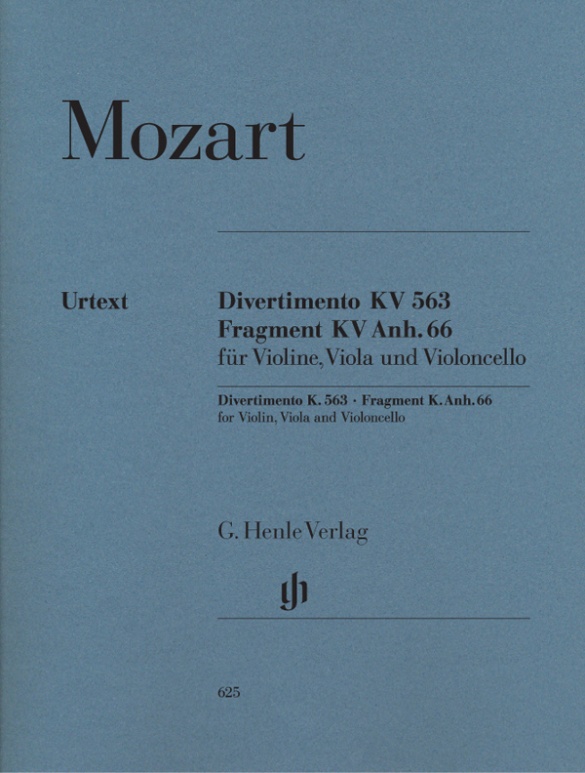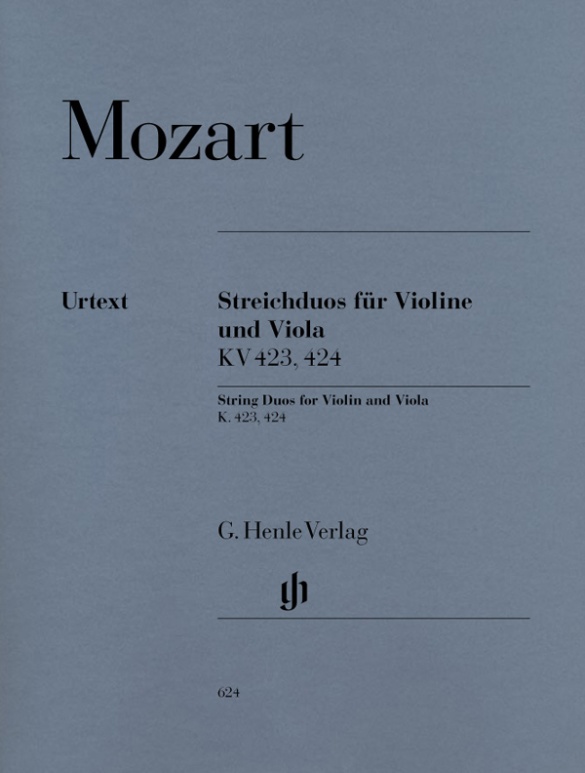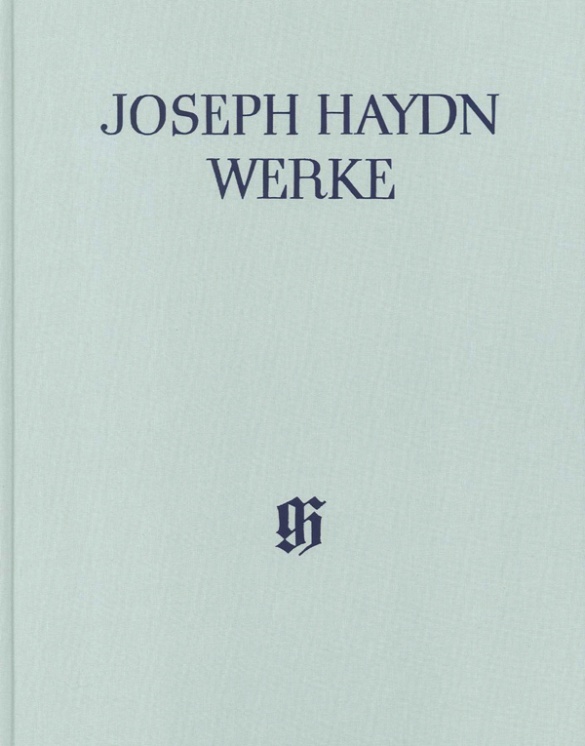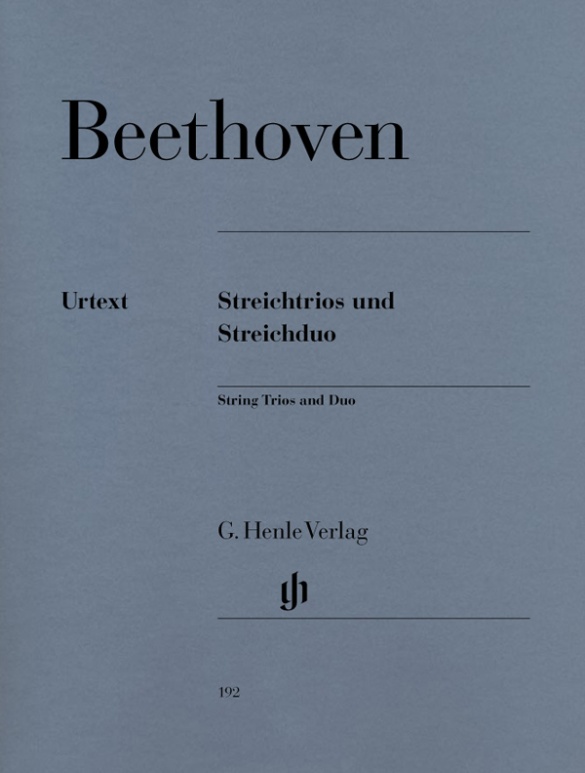

Wolfgang Amadeus Mozart
Divertimento K. 563 · Fragment K. Anh. 66
More than a few experts and aficionados count Mozart’s string trio in E-flat major K. 563 among his most magnificent compositions. This masterwork, entered into Mozart’s own catalogue of works on 27 September 1788 as a “Divertimento,” presents the Urtext editor with great challenges. The autograph manuscript has been lost since that time, and no other first-rate source texts exist. The most reliable, albeit clearly imprecise, source is the first edition, published two months after Mozart’s death. Many twentieth-century editions, however, unfortunately reprinted the musical text of Breitkopf & Härtel’s so-called “Alte Gesamtausgabe” (Old Collected Edition), which was edited by none other than the violinist Joseph Joachim on the basis of incorrect copies and is therefore completely corrupt. Even the “Neue Mozart-Ausgabe” (New Mozart Edition) is not error-free. The Henle edition essentially follows the first edition, though aided by numerous corrective interventions, described in the Critical Commentary. The edition’s Appendix presents the surviving fragment of the string trio movement in G major, K. Anh. 66 (562e). How unfortunate that Mozart never completed this equally wonderful music, which continues a little beyond the exposition and thus may quite aptly serve as a short encore. The three individual parts offer optimal flow for reading and playing thanks to the artful apportioning of notes in their layout, including, for instance, various foldout tables and individual pages left blank. The study edition (HN 9625), available separately, provides the full score to this edition of the parts.
Content/Details
About the Composer

Wolfgang Amadeus Mozart
Mozart is one of the few composers to have produced masterpieces in all genres. On the concert tours he undertook in his early years (London, Mannheim, Italy, Paris) he gained many varied musical impressions that he assimilated in his youth and which formed the prerequisite for his later consummate musical language.
| 1756 | Born in Salzburg on January 27, the son of musician and later court composer Leopold Mozart. His early regimented musical education from his father began in 1761, first compositions at age five. |
| 1763–66 | Extended concert tours through various German cities and to Paris, London, Amsterdam, Switzerland. He composes his first sonatas for violin and piano, K. 10–15, dedicated to Queen Charlotte, as well as the first symphonies from London, K. 16 and 19, which show the influence of the works of Johann Christian Bach and Karl Friedrich Abel (the three-movement Italian sinfonia form). |
| 1767 | Premiere in Salzburg of the sacred light opera “Die Schuldigkeit des ersten Gebotes,” K. 35 (written with Michael Haydn and Anton C. Adlgasser), and the intermezzo “Apollo et Hyacinthus,” K. 38. Journeys with his father and sister to Vienna. |
| 1768 | Probably the premiere in Vienna of his Singspiel “Bastien and Bastienne,” K. 50. Composition of his first masses. |
| 1769 | Performance in Salzburg of the dramma giocoso “La finta semplice,” K. 51. |
| 1769–71 | Two tours to Italy; he meets Farinelli, P. Nardini, and Padre Martini, among others, and, on the second trip, Hasse. Premieres in Milan of his opera seria “Mitridate, Re di Ponto” in 1770 and of the festa teatrale “Ascanio in Alba” in 1771. Composition of symphonies and his first string quartet (1770, K. 80). |
| 1771 | Composition of the oratorio “La Betulia liberate,” K. 118, in Salzburg/Italy. |
| 1772 | Premiere of the serenata drammatica “Il sogno di Scipione,” K. 126, for the accession of Salzburg Archbishop Hieronymus Count Colloredo. He receives an appointment as salaried concertmaster of the Salzburg Court Chapel (of which he had been an unpaid member since 1769). Third journey to Italy with his father, premiere in Milan of the dramma per musica “Lucio Silla,” with general success. The final trip to Italy spells the ends of his youthful phase of appropriation; he has tested out all important instrumental genres (symphony, sonata, string quartet) and all the main genres of opera (Singspiel, opera buffa, opera seria, festa teatrale). |
| from 1773 | Composition of string quartets (K. 168–173) under the influence of Haydn, and of symphonies, divertimenti, serenades. He increasingly devotes himself, contingent upon the duties of his post, to liturgical music; several masses are written. Begins to compose violin and piano concerti. |
| 1775 | Premiere in Munich of the dramma giocoso “La finta giardiniera” and the serenata “Il Rè pastore.” Piano sonatas, K. 279–284. |
| 1777 | He vacates his post temporarily to undertaken a promotional tour with his mother to Munich, Mannheim, and Paris. |
| 1778 | Composition of the “Paris” Symphony in D major (K. 297). In Paris he experiences the quarrel between the proponents of Gluck and those of Piccinni. Publication of violin sonatas. |
| 1779 | Resumes his duties in Salzburg, as court organist. Coronation Mass in C major. |
| 1781 | Premiere in Munich of his tragédie lyrique “Idomeneo,” in which French and Italian elements are synthesized. Journey to Vienna. After his falling out with the Archbishop of Salzburg, he gives up his post, moves to Vienna, and earns his living as a free composer through concertizing and giving music lessons. His last great period of creativity begins. |
| 1782 | He becomes acquainted with the works of Bach and Handel through Baron van Swieten; after this he arranges Bachian fugues and incorporates the “learned style” (fugues and counterpoint) into his works beside the “galant style” (e.g. in the String Quartet in G major, K. 387, in 1782; Piano Sonata in F major, K. 533, in 1786; the Jupiter Symphony, K. 551, in 1788; “Die Zauberflöte” (“The Magic Flute”), and the Requiem in D minor, K. 626, both in 1791). Premiere in Vienna of his Singspiel “Die Entführung aus dem Serail” (“The Abduction from the Seraglio”). Composition of the Haffner Symphony in D major, K. 385. |
| 1783 | Mass in C minor, K. 427; Linz Symphony in C major, K. 425. |
| 1784 | Hunt Quartet in B-flat major, K. 458. |
| 1785 | Premiere in Vienna of the oratorio “Davide penitente,” K. 469. “Dissonance” Quartet in C major, K. 465. |
| 1786 | Premiere of the comedy with music “Der Schauspieldirektor” (“The Impresario”), K. 486, which Salieri’s competing work “Prima la musica e poi le parole” (“First the Music and Then the Words”) bests. Premiere in Vienna of the opera buffa “Le nozze di Figaro” (“The Marriage of Figaro”), whose extended action-packed finales form a highpoint of opera buffa. Prague Symphony in D major, K. 504. |
| 1787 | Serenade in G major (“Eine kleine Nachtmusik”), K. 525. He is named imperial and royal chamber composer. Premiere in Prague of the dramma giocoso “Il dissoluto punito ossia Il Don Giovanni,” a synthesis of serious and comic opera. |
| 1788 | Composition of the large Symphonies in E-flat major, K. 543; G minor, K. 550; and C major (Jupiter Symphony), K. 551. Clarinet Quintet in A major, K. 581. |
| 1790 | Premiere in Vienna of the dramma giocoso “Così fan tutte ossia La scuola degli amanti.” |
| 1791 | Premiere in Prague of the opera seria “La clemenza di Tito” and in Vienna of the Singspiel “Die Zauberflöte.” Clarinet Concerto in A major, K. 622. The Requiem remains unfinished. Dies in Vienna on December 5. |
About the Authors

Wolf-Dieter Seiffert (Editor)
Dr. Wolf-Dieter Seiffert, born in 1959 in Frankfurt/M., read musicology, modern German literature, and philosophy at the Ludwig-Maximilians-Universität in Munich. On a scholarship from the “Studienstiftung des Deutschen Volkes”, he did his doctorate in 1990 with a thesis on “Mozarts frühe Streichquartette” (Rudolf Bockholdt). That same year, Seiffert started work at G. Henle Publishers as an editor. Parallel to his work at the publisher, he completed a diploma in business studies at the St. Gallen University, KMU-HSG, financed by the Günter Henle Foundation. Seiffert became managing director of G. Henle Verlag in 2000.
Seiffert has edited numerous Urtext editions for G. Henle Publishers, predominantly on Mozart’s works.
Product Safety Informations (GPSR)

G. Henle Verlag
Here you can find the information about the manufacturer of the product.G. Henle Verlag e.K.
Forstenrieder Allee 122
81476 München
Germany
info@henle.de
www.henle.com
Einmal mehr nimmt sich der Henle-Verlag der musikarchäologischen Aufgaben an und rekonstruiert und korrigiert fehlerhafte Tempoüberschriften und falsche Bindebögen. Diesmal beim Divertimento für Streichtrio, das oft als kammermusikalisches Juwel angesehen wird.
Schweizer Musikzeitung... bei dieser Ausgabe zahlreiche, teils gravierende Abweichungen von früheren Ausgaben (etwa der durch Hermann besorgten Edition bei Peters) in Sachen Artikulation und Dynamik zu vermerken sind, an denen nun kein Weg mehr vorbei führt, will man sich dem Werk ernsthaft nähern. ... Für die Spieler vielleicht relevanter als Quellenforschungskrimis dürften die Folgen sein: die "neuen" alten Striche machen viele Veränderungen erforderlich, die insgesamt zur sparsameren Verwendung des Bogens, zu luftigerem Strich zwingen - und vielleicht auch zu etwas rascheren Tempi. ... Großer Vorteil: Taktzahlen, vorbildlich übersichtliches Notenbild und sehr überlegte Wendestellen, für die man dankbar sein kann. Erwähnt werden muß außerdem der Fragmentsatz KV Anh. 66; ... ein reizvoller Blick auf einen unbekannten, unfertigen "Mozart" aus der Zeit um 1790/91.
Das LiebhaberorchesterUne partition qui fait partie de ses S.uvres de musique de chambre les plus accomplies. ... Cette partition fournit des commentaires détaillés de la genèse de ces 2 partitions.
Ecouter voir... Darum sollte Musikkritik unmißverständlich gute Ausgaben gut, mangelhafte aber schlecht nennen. Die Mozart-Ausgaben des Henle-Verlags, von denen hier eine Auswahl der jüngsten Produktion angezeigt wird, gehören allesamt zu den guten.Vom einstigen Lektor, dem inzwischen zum Verlagsleiter aufgestiegenen Wolf- Dieter Seiffert stammen die Editionen der beiden gewichtigsten Kammermusikwerke dieser Reihe, des Klavierquintetts KV 452 und des Divertimentos KV 563. Ersterer liegt das Autograph zugrunde, das in der Pariser Nationalbibliothek aufbewahrt wird, letztere folgt in Ermangelung einer mozartschen Eigenschrift dem postumen Erstdruck im Wiener Artaria-Verlag von 1792. Für die Gründlichkeit der investierten Quellenarbeit spricht im Falle des Quintetts die Einsicht, daß die alternative Schlußversion des Stücks, bislang (auch in der NMA) als von Mozart stammend angesehen, eine Fälschung darstellt (wer das Material im Original kennt, kann den Befund nur bestätigen). Dem Divertimento ist das Fragment eines G-Dur- Streichtrios beigegeben, an dem die Praxis zumindest das Vergnügen einer ausgearbeiteten Satzexposition finden mag, freilich auch die Enttäuschung eines unvermittelten Abbruchs nach wenigen Durchführungstakten erleben muß. Wer weniger an den Spielmaterialien und mehr an Partituren zum Studiengebrauch interessiert ist, der sollte beim Quintett und Divertimento (samt Fragment) zur jeweiligen Studien-Edition im vergrößerten Taschenformat greifen. Textidentisch mit den ,großen' Ausgaben, eröffnen die beiden Bände eine bequeme (und wohlfeile) Möglichkeit des eingehenden analytischen Studiums der Noten. ... Alle Ausgaben enthalten Vorworte mit knappen Abrissen der jeweiligen Entstehungs- und Überlieferungsgeschichte; bei den Kammermusikwerken sind außerdem Bemerkungen zur Textgestalt beigegeben. Fazit: Diese "taubenblauen Urtexte" sollten den Weg auf viele Notenpulte finden!
Acta Mozartiana推荐
autogenerated_cross_selling
本书目其他版本





